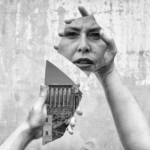“There’s this beautiful slipperiness to memory,” says artist Claudia Nicholson.
“It sort of gave way for ideas of regeneration as well.”
The UTS Artist in Residence has dived into personal memories and archives in her latest video and photography exhibition If the Mountain is Burning, Let it Burn, currently on display at the UTS Gallery.
Nicholson utilises photography spaces and workshops in reconstructing her connection to her birth country of Colombia. Adopted from Bogotá, she informs her artistic process in three forms of photographic archives of Colombia: photos taken by her father, photos taken by Nicholson and photo negatives obtained in Bogota.
In discussion with UTS Gallery curator Stella Mcdonald and senior curator for the Powerhouse Museum Ivan Muñiz Reed, Nicholson said her artistic practice originated
from exploring both her Colombian and Australian identity.
She described her process as an act of “vulnerability” by including biographical archives of her own and her father’s photography which span 70 years of Colombia’s
historical records and archives.
The primary image in the exhibition, Palace of Justice, Bogota (1986), was taken by her father, Stuart, months after the infamous Palace of Justice siege in August 1985 that killed 13 Supreme Court justices. For Nicholson, the historical ties were necessary in creating a “beautiful impartiality” against her biographical inclusion.
“There was a desire to return to Colombia but not a means to return. So I returned to that archive and those moments and I really closely studied each photograph,” Nicholson said.
“I just sort of wanted to see it all differently.”
As a newly explored medium for Nicholson, photography taken and developed using plastic bags and ink by the artist in collaboration with UTS Associate Professor Cherine Fahd resulted in hazy self portraiture.
This stemmed from photo negatives the artist bought in Bogota of unidentified people.

An image from If the Mountain is Burning, Let it Burn.
“I think about the ethics of including people I don’t know,” said Nicholson, who has also been working with senior lecturer Dr Marivic Wyndham. “I countered that by putting myself in the work.”
She describes her relationship to her birth country as of being “severed from a collective cultural memory”, using obscured mixed media and personal photographs
against undisrupted historical archivals to visualise.
If the Mountain is Burning, Let it Burn references Colombian musician Etelvina Maldonado’s Que Se Quema El Monte and Nicholson describes it as showcasing both “anger” and a “burning desire” to her connection.
If the Mountain is Burning, Let it Burn runs until November 29.
UTS Gallery, 702 Harris St, Ultimo, in the Peter Johnson Building (Building 6, Level 4).
Main image by Emilia Louw.




























